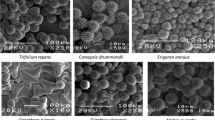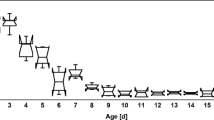Abstract
Different pollens have varying nutritional value for the honeybee. However, the digestion of the protein in the pollen is still not well understood. Here, we investigated this issue using a rectum-testing method. The results indicated that a higher proportion of the protein in camellia pollen is digested compared with the protein in rape pollen. Chemical and histochemical analyses indicated that protein digestion is closely associated with the diet that a worker bee consumes. Our results demonstrate that camellia pollen has a higher nutritive value than rape pollen for honeybees. By influencing midgut development, different bee diets cause discrepancies in digestive and absorptive functions, which are ultimately reflected by differences in protein digestion.



Similar content being viewed by others
References
Al-Ghamdi, A.A., Al-Khaibari, A.M., Omar, M.O. (2011) Consumption rate of some proteinic diets affecting hypopharyngeal glands development in honeybee workers. Saudi J. Biol. Sci. 18(1), 73–77
Black, J. (2006) Honeybee nutrition: review of research and practices. Rural Industries Research and Development Corporation, Canberra
Casartelli, M., Leonardi, M., Fiandra, L., Parenti, P., Giordana, B. (2001) Multiple transport pathways for dibasic amino acids in the larval midgut of the silkworm Bombyx mori. Insect Biochem. Mol. Biol. 31(6), 621–632
Crailsheim, K., Schneider, L., Hrassnigg, N., Bühlmann, G., Brosch, U., Gmeinbauer, R., Schöffmann, B. (1992) Pollen consumption and utilization in worker honeybees (Apis mellifera carnica): dependence on individual age and function. J. Insect Physiol. 38(6), 409–419
de Groot, A.P. (1953) Protein and amino acid requirements of the honeybee (Apis mellifica L.). Physiol. Comp. Oecol. 3, 197–285
Grogan, D.E., Hunt, J.H. (1980) Age correlated changes in midgut protease activity of the honeybee Apis mellifera (Hymenoptera, Apidae). Experientia 36(12), 1347–1348
Haydak, M.H. (1970) Honey bee nutrition. Annu. Rev. Entomol. 15(1), 143–156
Herbert, E., Bickley, W., Shimanuki, H. (1970) The brood-rearing capability of caged honey bees fed dandelion and mixed pollen diets. J. Econ. Entomol. 63(1), 215–218
Hoegger, R. (1998) Training papers nitrogen determination according to Kjeldahl. Büchi Labortechnik AG. Flawil 1, 18
Hrassnigg, N., Crailsheim, K. (1998) The influence of brood on the pollen consumption of worker bees (Apis mellifera L.). J. Insect Physiol 44(5), 393–404
Human, H., Nicolson, S., Strauss, K., Pirk, C., Dietemann, V. (2007) Influence of pollen quality on ovarian development in honeybee workers (Apis mellifera scutellata). J. Insect Physiol. 53(7), 649–655
Jensen, B.B., Jørgensen, H. (1994) Effect of dietary fiber on microbial activity and microbial gas production in various regions of the gastrointestinal tract of pigs. Appl. environ. Microbiol. 60(6), 1897–1904
Klungness, L.M., Peng, Y.S. (1984) A histochemical study of pollen digestion in the alimentary canal of honeybees ( Apis mellifera L.). J. Insect Physiol 30(7), 511–521
Li, C., Xu, B., Wang, Y., Feng, Q., Yang, W. (2012) Effects of dietary crude protein levels on development, antioxidant status, and total midgut protease activity of honey bee (Apis mellifera ligustica). Apidologie 43(5), 576–586
Lindauer, M. (1952) Ein beitrag zur frage der arbeitsteilung im bienenstaat. Zeitschrift für vergleichende Physiologie 34(4), 299–345
Lowry, O.H., Rosebrough, N.J., Farr, A.L., Randall, R.J. (1951) Protein measurement with the Folin phenol reagent. J. Biol. Chem. 193, 365–275
McDonald P. (2002) Animal nutrition. Pearson Education India.
Moritz, B., Crailsheim, K. (1987) Physiology of protein digestion in the midgut of the honeybee ( Apis mellifera L.). J. Insect Physiol 33(12), 923–931
Nicolson, S.W., Human, H. (2013) Chemical composition of the ‘low quality’ pollen of sunflower (Helianthus annuus, Asteraceae). Apidologie 44, 144–152
Pirk, C.W.W., Boodhoo, C., Human, H., Nicolson, S.W. (2010) The importance of protein type and protein to carbohydrate ratio for survival and ovarian activation of caged honeybees (Apis mellifera scutellata). Apidologie 41, 62–72
Pernal, S.F., Currie, R.W. (2000) Pollen quality of fresh and 1-year-old single pollen diets for worker honey bees (Apis mellifera L.). Apidologie 31(3), 387–410
Peters, W. (1992) Peritrophic membranes (Vol. 30). Springer.
Roulston, T.H., Cane, J.H. (2000) Pollen nutritional content and digestibility for animals. Plant Syst. Evol. 222, 187–209
Roulston, T.H., Cane, J.H., Buchmann, S.L. (2000) What governs protein content of pollen: pollinator preferences, pollen-pistil interactions, or phylogeny? Ecol. Monogr. 70(4), 617–643
Rosca O. C., Rusu F. C. (1972) Effect of protein supplements on the developments and secretory activity of the hypopharyngeal glands in the honeybees. Lucr. Stiint. Inst. Agron H.: 93–98.
SAS Institute. (2003) SAS/STAT User’s Guide: Version 9.1th edn.
Schmidt, J.O., Buchmann, S.L. (1985) Pollen digestion and nitrogen utilization by Apis mellifera L. (Hymenoptera: Apidae). Comp. Biochem. Physiol. Part A: Physiology 82(3), 499–503
Shi, J.R., Liu, B., Ma, Y., Shen, Y.H. (2010) Advances in research of peritrophic membrane in insects. Newsl. Seric. Sci. 30(3), 7–13
Szolderits, M.J., Crailsheim, K. (1993) A comparison of pollen consumption and digestion in honeybee (Apis mellifera carnica) drones and workers. J. Insect Physiol. 39(10), 877–881
Tettamanti, G., Grimaldi, A., Casartelli, M., Ambrosetti, E., Ponti, B., Congiu, T., Ferrarese, R., Rivas-Pena, M.L., Pennacchio, F., Eguileor, M. (2007) Programmed cell death and stem cell differentiation are responsible for midgut replacement in Heliothis virescens during prepupal instar. Cell Tissue Res. 330(2), 345–359
Tettamanti, G., Malagoli, D., Marchesini, E., Congiu, T., de Eguileor, M., Ottaviani, E. (2006) Oligomycin A induces autophagy in the IPLB-LdFB insect cell line. Cell Tissue Res. 326(1), 179–186
Vanderplanck, M., Leroy, B., Wathelet, B., Wattiez, R., Michez, D. (2013) Standardized protocol to evaluate pollen polypeptides as bee food source. Apidologie . doi:10.1007/s13592-013-0239-0
Wang, G.Y., Wu, Z.F., Yang, W.R., Xu, B.H. (2011) Effects of dietary protein levels on hypopharyngeal gland development and royal jelly production of Apis mellifera L. Chin. J. Anim. Nutr. 23, 1147–1152
Wang, X.R. (2000) The progress of study on the physiology and histopatology of insect midgut. J. Zhongkai Agrotechnical College 13(1), 58–68
Winston M. L. (1991) The biology of the honey bee. Harvard University Press.
Yu, B., Chiou, P.W.S. (1997) The morphological changes of intestinal mucosa in growing rabbits. Lab. Anim. 31(3), 254–263
Zhang, T., Gui, H., Yue, Z.G., Yang, Y., Gao, X.H., Yang, F.H., Xing, X.M. (2012) Effects of dietary protein level on gastrointestinal digestive enzyme activity and jejunal morphology in minks during winter hair period. Chin. J. Anim. Nutr. 24(2), 376–382
Zhou, Q., Xiong, Z.Y., Ou, X.M. (2011) Effects of sterols from Xanthium sibiricum (Compositae) on feeding, enzyme activities in the hemolymph and midgut, and midgut tissues of Pieris rapae (Lepidoptera: Pieridae) larvae. Acta Entomol. Sin. 54(9), 1034–1041
Acknowledgements
We are grateful to Li, X. Y., Liu, Z. H., Sun, R. J., Zhang, G. L. and Zhang, G. J. for assistance. This research was financially supported by the earmarked fund for the China Agriculture Research System (CARS-45) and the Special Fund for Agro-Scientific Research in the Public Interest (no. 200903006).
Author information
Authors and Affiliations
Corresponding author
Additional information
Manuscript editor: Klaus Hartfelder
Digestion de la protéine de deux types de pollen par les abeilles ( Apis mellifera ) en Chine
Valeur nutritionnelle / pollen / camélia / colza / mécanismes de la digestion
Verdauung der Proteine von zwei Pollentypen aus China durch die Honigbiene ( Apis mellifera )
Apis mellifera / pollen / proteinverdau / mechanismus
Rights and permissions
About this article
Cite this article
Wang, Y., Ma, LT., Hang, XB. et al. Digestion of protein of two pollen types in China by the honeybee (Apis mellifera L). Apidologie 45, 590–600 (2014). https://doi.org/10.1007/s13592-014-0278-1
Received:
Revised:
Accepted:
Published:
Issue Date:
DOI: https://doi.org/10.1007/s13592-014-0278-1




